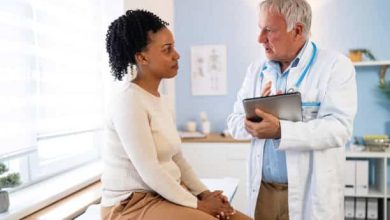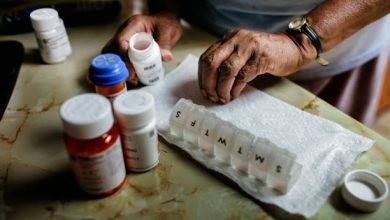I Was Only 33 — I Never Thought It Would Be Cancer – BlackDoctor.org


When Sydney Barned was first diagnosed with stage 4 lung cancer, she was just 33 years old — a young medical intern focused on saving lives, not fighting for her own.
“I was diagnosed in February of 2017. I started having symptoms probably a year before that. At that point in time, I was living in Jamaica,” Dr. Barned tells BlackDoctor.
It began subtly. Dr. Barned, an avid runner, noticed she was becoming short of breath.
“I used to do a lot of 5K runs and I realized that when I was jogging, I was kind of huffing and puffing along, I wasn’t feeling very good. And I wondered what was going on,” Dr. Barned recalls.
She chalked it up to being out of shape because she wasn’t running as often as she used to. Until one night, things took a frightening turn.
“One night, I woke up feeling like I couldn’t get air into the left side of my chest,” she says.
Working in an emergency department in Jamaica, she went in for an X-ray.
The X-ray showed something alarming: a pretty large whiteout on the left lower part of her lung.
“They treated me as a walking pneumonia [patient] because I didn’t have any red flag symptoms. I wasn’t having any weight loss, any cough, cold, anything like that,” Dr. Barned explains.
But after being diagnosed with pneumonia in Jamaica, she developed a persistent cough that prompted her to see a pulmonologist. She was eventually diagnosed with hyperactive airway disease and prescribed steroids. The treatment helped, and by April 2016, her cough had become mostly intermittent.
After moving to the United States in May 2016, Dr. Barned began experiencing intermittent wheezing that August, often triggered by strong odors. When the wheezing became more persistent later in the year, she consulted a pulmonologist at her teaching institution. Given her strong family history, further testing was initiated to evaluate her for asthma.
She was subsequently sent for a repeat chest X-ray. “The radiologist noted a small consolidation in the lower left lung—the same spot where I’d had an issue the year before,” Dr. Barned explains. “I asked my pulmonologist in the States to order a CT scan, because if it were just a typical pneumonia, it should have resolved by then. It shouldn’t have appeared in the exact same place.”

A Doctor Becomes a Patient
Her intuition, something she learned as a doctor-in-training, proved right.
“The CT scan came back showing that I had a mass, compressing my airway. And that’s why I was wheezing, and that’s why I had the abnormality on the X-ray in the same exact spot, because that mass was there,” Dr. Barned shares.
“We’re taught that if there’s an abnormality on imaging in the same spot over an interval of time, more than likely it is post-obstructive,” she adds. “I looked at the X-ray and the image looked so much better than the one I had in Jamaica, but when I read the report… I instantly freaked out. I started crying, I started bawling, because I was like, there’s something in my lungs.”
Her resident reassured her that it was “probably something benign,” but Dr. Barned insisted on the CT. “Thankfully, my pulmonologist listened to me,” Dr. Barned adds. “And of course, then that’s when everything kind of went whirlwind after that.”
Within a month, she learned she had stage 4 lung cancer — with an ALK mutation, a genetic alteration, or biomarker, that makes the cancer responsive to targeted therapy.
“When I was diagnosed in 2017, the survival rates were approximately 15 percent for five-year survival,” Dr. Barned says. “I was like, I’m only 33. This makes no sense. I didn’t smoke. Did I waste all my years in school? Am I going to be here in five years?”
According to the latest State of Lung Cancer report from the American Lung Association, the five-year survival rate has now climbed to nearly 30 percent—a 26 percent increase in just five years.
Not eligible for the Family and Medical Leave Act disability, Dr. Barned struggled with the thought of how to keep going.
“That goes through your brain…You still go through…facing your mortality, the financial consequences of cancer. What is my life going to be like in the next five years? The plans that you had put out there for your future, or you thought you had in mind, right now [are] suddenly hazy or disappear,” she says.
Dr. Barned also had to cope with the fact that she was now dealing with a form of cancer that she didn’t think she was at risk for.
“It was a lot to go through, especially when I did not think that I would have any risk factors… I was the teenager who used to scold my friends about smoking because of the risk of lung cancer. I used to tell them, ‘Don’t smoke around me,’ because I felt like I would probably be hyper-reactive to the smoke… So for me, to be the same person to turn around and get lung cancer was literally a slap in the face,” she shares.
The Power of Biomarker Testing
The ALK mutation — discovered through comprehensive biomarker testing — changed everything for Dr. Barned. Instead of chemotherapy, she was able to start oral targeted therapy, which allowed her to continue her residency while undergoing treatment with fewer side effects.
“There is no way I would have been able to do that with the debilitating side effects of chemotherapy,” she says. “I feel so blessed that I was tested and found to have a mutation because I see the difference with my trajectory in comparison to others who didn’t get the testing done right away.”
Dr. Barned also emphasizes that biomarker testing can be life-changing.
“Anyone who gets diagnosed with lung cancer, especially non-small cell lung cancer, should ask their doctors to get biomarker testing regardless of their smoking status,” she says. “While yes, it is found at a higher percentage in non-smokers, some smokers can have a biomarker — and if the biomarker actually has a target, then those therapies are tolerated much better than chemotherapy.”
For patients worried about cost, she adds: “A lot of the companies that do biomarker testing also have some financial aid component to help pay for the test if insurance companies are not paying for it.”
Barriers and Advocacy
Dr. Barned has since become an advocate for equitable access to comprehensive biomarker testing. This year, she partnered with the American Lung Association to help bring more awareness and understanding to lung cancer screening and biomarker testing through the Biomarker Education, Awareness, and Testing for Lung Cancer (BEAT Lung Cancer) initiative. With a particular emphasis on communities bearing the highest lung cancer burden, together, they created a video spotlighting Dr. Barned’s story and her message for both patients and her healthcare professional peers. [Watch her video here.]
“Unfortunately, disproportionately, we [Black Americans] are affected with many different things, including not being sent for biomarker testing,” she says.
In fact, survival rates are 28.6 percent for white individuals, but only 24.9 percent for Black individuals and 22.8 percent for Indigenous people. Furthermore, more than 1 in 5 people (21 percent) diagnosed with lung cancer receive no treatment at all, according to the Lung Association’s report.
“A lot of the times, biomarker testing is still quite expensive. If someone doesn’t have medical insurance, that’s another barrier,” Dr. Barned adds.
She also testified before the Maryland State Senate and House of Representatives for a biomarker bill to ensure coverage.
“It went into effect for commercial insurers, but there was a delay with Medicare insurers,” she says. “When you take into account socioeconomics… if people are not medically aware that biomarkers exist, then they’re not going to ask their physicians. And unfortunately, some physicians themselves don’t know.”
Because of this, she’s passionate about the importance of awareness of lung cancer and biomarker testing among both patients and doctors.
“A lot of my friends who were diagnosed young — they were dismissed because they were young,” she says. “From the clinician side, that’s the number one reason they dismiss them. It’s because of their age. But I know people who were diagnosed in their 20s… even teens. It’s not just a disease of 60- and 70-year-olds anymore.”

Life After Diagnosis
Eight years after her diagnosis, Dr. Barned is thriving. “I was able to start my medications and continue my residency. I was able to graduate on time with my cohort. I was a chief resident in my third year,” she says proudly. “Now I’m still working full-time. I’m able to travel, to work out, to start jogging. I am living a normal life — very similar to what I probably would live if I were not diagnosed.”
Still, survivorship brings lingering worries.
“Will my treatment stop working? Will I have to stop working? If I stop working, am I going to be able to afford insurance?” she admits. “It also gives you a great appreciation for the good days that you have.”
Dr. Barned has shifted her focus to what truly matters.
“They’re not going to write on a tombstone, ‘Oh, she was a good doctor,’” she says. “What’s going to be on it is: Was I a good person? Was I a good friend? Was I a good daughter?”
A Call for Awareness
Each November, Sydney notices how quiet Lung Cancer Awareness Month is compared to October’s sea of pink.
“Every October, you see pink, pink, pink — and I’m not saying anything is wrong with that,” she says. “But there is such a stark difference in November. I see absolutely nothing. The support for lung cancer is not there because the public still thinks it’s a smoker’s disease.”
That stigma, she says, prevents progress. According to the Centers for Disease Control (CDC), 10-20 percent of those diagnosed with lung cancer are non-smokers.
“Cancer is not something that people do to themselves. Nicotine is a very addictive drug. There’s not enough going into smoking cessation, and there’s not enough going into education, screening, and awareness of lung cancer,” Dr. Barned says.
For Dr. Barned, advocacy is personal. “Three years after I was diagnosed, my aunt was diagnosed with lung cancer as well,” she shares. “She did have a biomarker test done, but hers was harder to treat, and she succumbed to the disease three years later. She was a non-smoker.”
Her message is simple but urgent: “We need more awareness. We need more empathy. We need more research.”
If you or a loved one have been diagnosed with lung cancer, comprehensive biomarker testing can help determine what treatment options would be best for you and your chances to beat lung cancer. The American Lung Association is raising awareness about lung cancer screening and comprehensive biomarker testing and is hoping to learn more about people’s unique experience with biomarker testing after a lung cancer diagnosis. Take their short survey here.



